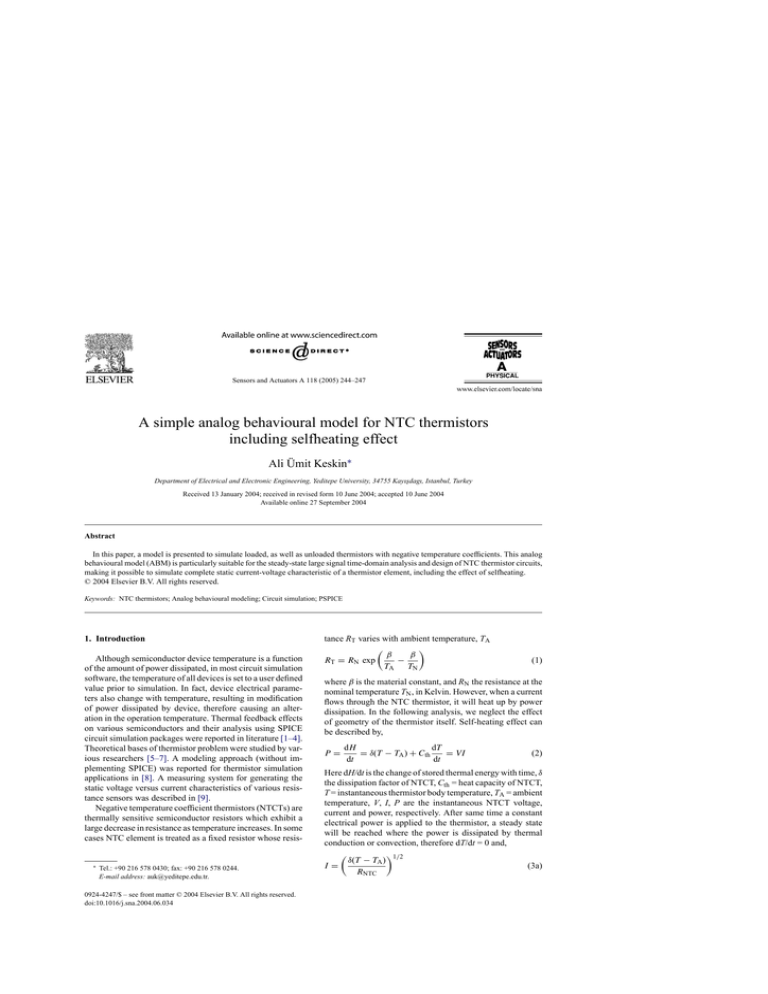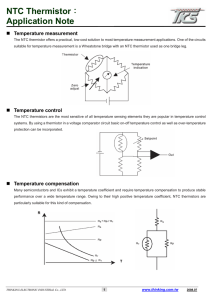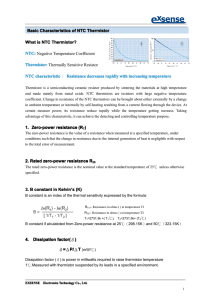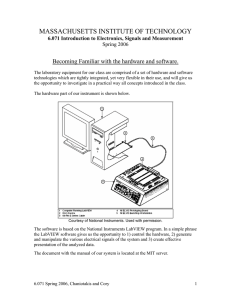
Sensors and Actuators A 118 (2005) 244–247
A simple analog behavioural model for NTC thermistors
including selfheating effect
Ali Ümit Keskin∗
Department of Electrical and Electronic Engineering, Yeditepe University, 34755 Kayışdagı, Istanbul, Turkey
Received 13 January 2004; received in revised form 10 June 2004; accepted 10 June 2004
Available online 27 September 2004
Abstract
In this paper, a model is presented to simulate loaded, as well as unloaded thermistors with negative temperature coefficients. This analog
behavioural model (ABM) is particularly suitable for the steady-state large signal time-domain analysis and design of NTC thermistor circuits,
making it possible to simulate complete static current-voltage characteristic of a thermistor element, including the effect of selfheating.
© 2004 Elsevier B.V. All rights reserved.
Keywords: NTC thermistors; Analog behavioural modeling; Circuit simulation; PSPICE
1. Introduction
Although semiconductor device temperature is a function
of the amount of power dissipated, in most circuit simulation
software, the temperature of all devices is set to a user defined
value prior to simulation. In fact, device electrical parameters also change with temperature, resulting in modification
of power dissipated by device, therefore causing an alteration in the operation temperature. Thermal feedback effects
on various semiconductors and their analysis using SPICE
circuit simulation packages were reported in literature [1–4].
Theoretical bases of thermistor problem were studied by various researchers [5–7]. A modeling approach (without implementing SPICE) was reported for thermistor simulation
applications in [8]. A measuring system for generating the
static voltage versus current characteristics of various resistance sensors was described in [9].
Negative temperature coefficient thermistors (NTCTs) are
thermally sensitive semiconductor resistors which exhibit a
large decrease in resistance as temperature increases. In some
cases NTC element is treated as a fixed resistor whose resis∗
Tel.: +90 216 578 0430; fax: +90 216 578 0244.
E-mail address: auk@yeditepe.edu.tr.
0924-4247/$ – see front matter © 2004 Elsevier B.V. All rights reserved.
doi:10.1016/j.sna.2004.06.034
tance RT varies with ambient temperature, TA
β
β
RT = RN exp
−
TA
TN
(1)
where β is the material constant, and RN the resistance at the
nominal temperature TN , in Kelvin. However, when a current
flows through the NTC thermistor, it will heat up by power
dissipation. In the following analysis, we neglect the effect
of geometry of the thermistor itself. Self-heating effect can
be described by,
P=
dH
dT
= δ(T − TA ) + Cth
= VI
dt
dt
(2)
Here dH/dt is the change of stored thermal energy with time, δ
the dissipation factor of NTCT, Cth = heat capacity of NTCT,
T = instantaneous thermistor body temperature, TA = ambient
temperature, V, I, P are the instantaneous NTCT voltage,
current and power, respectively. After same time a constant
electrical power is applied to the thermistor, a steady state
will be reached where the power is dissipated by thermal
conduction or convection, therefore dT/dt = 0 and,
δ(T − TA ) 1/2
I=
(3a)
RNTC
A.Ü. Keskin / Sensors and Actuators A 118 (2005) 244–247
245
or
V = (δ(T − TA )RNTC )1/2
(3b)
which yield the parametric description of the V/I curves that
are calculated for different (constant) ambient temperatures.
The linear part of log–log plotted V/I characteristic curve
of NTCT is used when this element is employed as a
temperature sensor. Beyond a certain limit, V/I characteristic
behaves in non-linear fashion, first reaching a maximum and
than displaying a negative resistance behaviour. There are
many applications which are based upon the static V/I NTCT
characteristic. (a) Applications where δ is varied (which
is exploited in flow meters, vacuum manometers, liquid
level control, and gas chromatography). (b) Applications
where the electrical parameters of the circuit are varied. (c)
Applications where the ambient temperature is varied which
can be due to radiation absorbed by the thermistor, such as
in microwave power measurement. Considering the cost of
physical realization in these wide variety of applications, as
well as the time spent in their design, it is apparent that, a
model which helps to simulate NTCT steady-state response
including selfheating (i.e., simulating complete static I–V
characteristic, rather than partial formulations) will be advantageous. Motivated by this fact, a model is presented in this
paper to simulate the NTC thermistor behaviour including
the effect of selfheating in dc operating point analysis.
Fig. 1. Typical linear scaled I–V characteristics for a NTCT (S-237-10, [10]),
at various ambient temperatures. These curves are constructed using the
manufacturer data for δ = 17 mW/K.
As one can see, nodes 5 and 6 have been added in the
sub-circuit statement. The ambient temperature, V(5, 6) is
included in the characteristic equation, also. This is the sensor’s temperature in volts (but it represents degrees celsius).
Finally, characteristic equation has been included in the “eth”
statement to create the NTCT model.
However, if the element operates in its non-linear I/V
region, this model is insufficient to completely describe a
NTCT.
2. Modeling of NTC thermistors
3. Electrically loaded NTC thermistor
In conventional circuit analysis software, an unloaded
NTCT can be modelled with a look-up table, or an expression
can be used to describe how the resistance varies with temperature by implementing an analog behavioural model (ABM).
Here, procedure is to sense the current (I) and then generate the voltage V (=IR) with a voltage source. For example,
to sense current, recent versions of PSPICE uses a voltage
source which is set to 0 V, so there’s no effect on the output
voltage. The other source, which is connected in series to the
first one, generates the voltage across the “resistor” based on
the sensed current times the desired resistance. The important
aspect of this source is that its output voltage can be described
by an equation. The “resistor” described above is extended to
include the characteristic equation of the NTCT and the sensor’s temperature, to create the NTCT model. The sensor’s
temperature and the voltage nodes are included symbolically
in the characteristic equation in volts (represents degrees celsius), and in the sub-circuit statement, respectively. For example, the subcircuit NTC given below defines the resistance
of a 1 k NTCT (with β = 3060), as follows:
As long as data of a given NTCT are in hand, it is possible
to compute the characteristic.
I–V curves at different ambient temperatures as shown
in Fig. 1, and modify a PSPICE model described above, to
represent steady state selfheated NTCT behaviour. The temperature change due to selfheating can be given as,
.subckt NTC 1 2 5 6
eth 1 3 value = {i(vs) × 1k × exp(3060/(v(5, 6)+273) −
3060/(298))}
vs 32 dc 0
.ends
∆T = TX − TA =
IV
δ
(4)
Here temperature circuit is modified by the addition of a selfheating temperature equivalent of voltage source whose value
is made equal to the change in voltage. This is shown in Fig. 2
Fig. 2. Complete PSPICE ABM for NTCT with selfheating effect.
VALUE(E1)= I(V6) RN exp[β/(V%IN1+, %IN1−) + 273) − β/298],
VALUE(E3)= I(V6)(V%IN3+, %IN3−)/δ.
246
A.Ü. Keskin / Sensors and Actuators A 118 (2005) 244–247
Fig. 3. Resistance vs. temperature curves of (A) unloaded NTC thermistor,
RN = 10 , without linearization, (B) same NTCT linearized by a parallel
fixed resistor of 10 , under no-load conditions, (C) same NTCT with a
current IT = 200 mA and in parallel with a fixed resistor of 10 .
which is a generalized form of the NTCT ABM model including the selfheating (thermal feedback) effect, using PSPICE
simulation package [11]. In this figure, voltage source V6
is used to sense current, which is set to 0 V, E1 generates
the voltage across the “NTCT” based on the sensed current times the NTCT resistance. V1 represents the “ambient temperature”, while E3 is an ABM component which
provides the selfheating information in thermal circuit. The
resistors R1 and R2 have high values; however, proper R2
value must be selected, for example, if the NTCT is to be
linearized.
Example: Assume that a NTCT whose dissipation constant is 17 mW/K and steady state I–V curve is shown in
Fig. 1 [10], operates at 25 ◦ C under no load conditions. If the
current is increased to 200 mA, the amount of self heating at
steady state will be (0.2 A) (1.255 V)/(0.017) = 14.8 ◦ C, and
NTCT temperature will be 39.8 ◦ C. Therefore, in the abovegiven PSPICE netlist, the value of v(5, 6) is now 39.8 V. If it is
required to design a linearized, unloaded NTCT circuit with
this component within the temperature range 270–330 K, a
parallel connected fixed resistor RP = 10 can be used. This
yields a fair linearization of the R–T characteristics around
the ambient (=nominal) temperature of NTCT, as shown in
Fig. 3B, under no-load conditions. However, this “linearity”
is offset by the amount of selfheating, if considerable amount
of current flows through the thermistor, e.g., INTCT = 200 mA,
as depicted in Fig. 3C.
As a check of how well the model can predict
current–voltage characteristic curves for a given NTCT at
different ambient temperatures, the current source I2 is swept
in the interval of (0–1 A) while keeping the V4 voltage fixed
in Fig. 2, corresponding to constant ambient temperature.
PSPICE reconstructed current–voltage characteristic curve
obtained from the NTCT ABM (Fig. 2) at 25 ◦ C ambient
temperature is shown by curve A of Fig. 4 As shown by Eqs.
Fig. 4. PSPICE reconstructed current–voltage characteristic curve obtained
from the NTCT ABM proposed in Fig. 2. The curve A is for δ = 17 mW/K
in still air, while B is for δ = 25 mW/K non-conductive liquid. Ambient
temperature is 25 ◦ C.
(3a) and (3b) the voltage/current curve is influenced not only
by the NTCT resistance RT , but also by the dissipation factor
δ, which depends on size, shape and leads of the device as
well as on the medium surrounding the thermistor. In stirred
air or in a liquid the dissipation factor increases and the V/I
curve shifts towards higher values of voltage and current.
The voltage/current curve thus indicates by which medium
the thermistor is surrounded. The curve B of Fig. 4 demonstrates this fact using the proposed NTCT model, assuming
that the element is immersed in a dielectric liquid, causing
NTCT dissipation factor to have a new value of 25 mW/K at
the same ambient temperature (TA = 25 ◦ C).
Using the proposed model, response of the NTCT (whose
parameters [10] have been given above) to different unbiased
sinusoidal currents with different amplitudes (but the same
frequencies) at TA = 25 ◦ C (still air), are depicted in Fig. 5.
The voltage waveform observed over the element has been
Fig. 5. Time domain transient analysis of the NTCT ABM for two sinusoidal
currents of the same frequencies (50 Hz) with different amplitudes, in still
air at 25 ◦ C. (A) Imax = 0.1 A, (B) Imax = 1 A.
A.Ü. Keskin / Sensors and Actuators A 118 (2005) 244–247
distorted for larger amplitude current input, as expected from
the inspection of (both calculated and simulated) V/I curves
of the NTCT under consideration.
A comparative analysis of the reconstructed I/V curves
with the corresponding ones plotted in Fig. 1 proves that the
proposed NTCT ABM is a good approximation to simulate
the steady-state behaviour of NTC thermistors.
4. Conclusion
An analog behavioural model is presented in this paper
to simulate the NTC thermistor behaviour including the selfheating effects in dc operating point analysis. The method
proposed in this work uses currently available circuit simulation software, such as PSPICE. This method is found to
be an effective tool for the steady-state large signal time
domain analysis of NTCTs whose specifications are either
given by their manufacturers or determined experimentally.
A comparison of the simulation results employing the proposed NTCT ABM with the corresponding theoretically calculated ones using manufacturer specified data proves that the
NTCT model presented in this work is a good approximation
to simulate the steady-state behaviour of NTC thermistors,
including the effect of selfheating.
References
[1] K. Lu, P. Halloran, T.J. Brazil, Simple method to simulate diode
selfheating using SPICE, Electronics Lett. 28 (1992) 1667–1669.
[2] D.T. Zwidinger, S.G. Lee, R.M. Fox, Compact modeling of BJT
self-heating in SPICE, IEEE Trans. Computer-Aided Des. CAD-12
(1993) 1368–1375.
247
[3] S. Nooshabadi, G.S. Visweswaran, D. Nagchoudhuri, A MOS transistor thermal sub-circuit for the SPICE circuit simulator, Microelectron. J. 29 (4–5) (1998) 229–234.
[4] H. Rudolph, Simulation of thermal effects in integrated circuits with
SPICE—a behavioural model approach, Microelectron. J. 24 (8)
(1993) 849–861.
[5] R.G. Lueck, T.R. Osborn, The characteristics of internally heated
thermistors, Deep Sea Res., Part A: Oceanographic Res. Pap. 27
(3–4) (1980) 273–292.
[6] J.D. Howison, J.F. Rodrigues, M. Shillor, Stationary solutions to
the thermistor problem, J. Mathematical Anal. Appl. 174 (2) (1993)
573–588.
[7] A.S. Wood, S. Kutluay, A heat balance integral model of the thermistor, Int. J. Heat Mass Transfer 38 (10) (1995) 1831–1840.
[8] T. Veijola, Electrothermal simulation models for NTC and PTC
thermistors, in: Proceedings of CSC 98, vol. 2, Piraeus, 1998, pp.
950–955.
[9] D. Stankovic, M. Zlatanovic, Versatile computer controlled measuring system for recording voltage — current characteristics of various resistance sensors, Sens. Actuators A: Phys. 42 (1–3) (1994)
612–616.
[10] NTC Thermistors Data Book; EPCOS (Siemens Matsushita Components), 5/2002.
[11] PSPICE, ORCAD Family release 9.2 Lite Edition.
Biography
Ali Ümit Keskin was born in Bursa, Turkey. He received his BSEE degree
from Bogazici University in 1978, MSEE from Yildiz University (1980)
and PhD degree from the Institute of Science and Technology, Istanbul
Technical University (1984), respectively. In 1985, he joined Siemens
AG, Turkey. He was engaged in the field of Medical Imaging Technology
throughout his professional career in Siemens AG. Since September 2002,
he has been affiliated as an assistant professor in Department of Electrical
Engineering, Yeditepe University, Istanbul. His main research interests are
analog signal processing, sensors and transducers, spectroscopy, medical
imaging theory and its applications.







